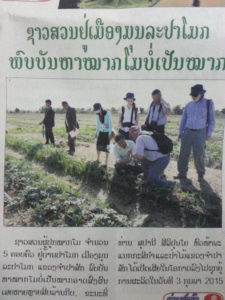
NSW Committee tours Laos
February 6, 2015
A group of our NSW Committee members are on a self-funded tour to Laos to visit some of the volunteers, trainees and projects they have funded over the years, and to also learn more about Australian projects in the region.
The group is being ably led by Lester Burgess who received the Crawford Fund medal for his many years of effort around plant pathology in the region. Lester has been active running a range of training programs but also in developing opportunities for young Australian volunteers to build regional capacity around plant pathology with volunteers from Scope Global, an Australian government funded volunteer program.
Lester and his wife Jillian have been in Laos for some weeks now, with Lester doing field trips and Jillian teaching English, but the NSW Committee are now in-country. Helen Scott-Orr, coordinator of the NSW Committee, is sending us photos and descriptions of what they are experiencing.
The team’s visit was reported in the Champamai Weekly Newspaper (No. 725 9-13 Feb. 2015 pp. 1 and 9). A transcript of the article follows:
Farmers in Mounlapamok District have problems with watermelons; the plants don’t produce fruit
 Five families growing watermelons in Pamok Village, Champasak Province are having problems with watermelons: the plants don’t produce fruit. This might cause losses worth tens of millions of kip, Mr. Souphany Silipounnyoh, Head of the Champasak Provincial Agriculture and Forestry Office, revealed when taking the opportunity to go into the field to motivate production on February 3, 2015. He said that the reason is that the soil is depleted and hasn’t been restored and improved after being used for cultivation for many seasons.
Five families growing watermelons in Pamok Village, Champasak Province are having problems with watermelons: the plants don’t produce fruit. This might cause losses worth tens of millions of kip, Mr. Souphany Silipounnyoh, Head of the Champasak Provincial Agriculture and Forestry Office, revealed when taking the opportunity to go into the field to motivate production on February 3, 2015. He said that the reason is that the soil is depleted and hasn’t been restored and improved after being used for cultivation for many seasons.
Mr. Long, one of five families growing watermelon, said when interviewed that “I have been growing watermelons as profession for ten years and every year there has been no problems with production. It has been sufficient to provide an income of 50-60 million kip per year. So this year the area for production was increased by 5 ha using a loan of 30 million kip for each family at a low interest rate from the Policy Bank. But the plants are stunted, the vines haven’t expanded and no watermelons have been produced. Usually 15 days after planting the watermelons are big enough to sell but after 42 days still no watermelons have appeared. We don’t know the reason why. Therefore those concerned and experts have come to analyze what is wrong. These negative effects are causing losses worth tens of millions of kip.”
Mr. Souphany Silipounnyoh when interviewed added “One of the main reasons why the plants haven’t expanded is that the soil has lost its quality after production over many seasons. The farmers have applied fertilizer but in small quantities. This has made the soil hard. The roots of the watermelons can’t expand so that no watermelons are produced. The solution is that the farmers must improve the soil with sufficient amounts, from the beginning at the growing seedling stage to when rows are made for growing the plants, so that the soil is not too compacted and the roots can expand. The second method is to grow other plants in order to improve the soil, for example legumes (soybeans, mungbeans), then plough them into the soil. We have experts on clean agriculture production who have come to the field to study and collect watermelon plants in order to experiment and find out what is the cause or what disease it is. After that they will research methods for protection and solutions. This will require time.”
News and photo: Khamla





 0
0